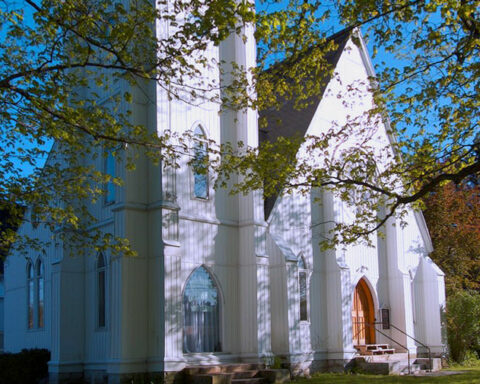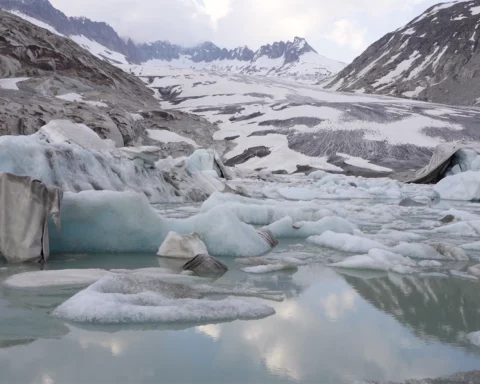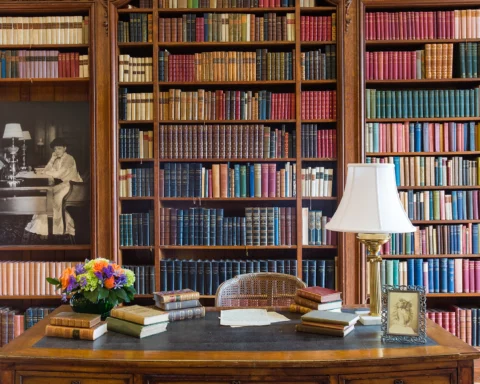“My interest in browning the white cube — by building with adobe bricks, making brown bodies present — is a response to entering traditional art spaces and not seeing myself reflected. This has been the case not just physically, in terms of the whiteness of those spaces, but also in terms of the histories of art they uphold”
Rafa Esparza, ArtForum, November 21, 2017
Like a shotgun in the face, white DDT is fired into the face of Mexican workers. This is the first image seen as you enter MASS MoCA’s Michael & Agnese Meehan Gallery, it’s only small, climate-controlled space now housing Rafa Esparza’s installation, staring at the sun. The painting depicts the real life practice utilized by the Bracero Program of fumigating Mexican farm Laborers with DDT (Bracero Program was an agreement between the United States and Mexico to allow Mexican workers to come to the United States between 1942 – 1964). Painted on brown clay from the Hoosic River, the spray blasting towards the worker gives the sense of bleaching or obliterating his brown skin, much in the way museums and cultural institutions have, for centuries, erased race and gender identity from their walls. Los Angeles multi-disciplined artist, Rafa Esparza, aims to change this — he is browning the white box

Learning the time honored method of building adobe bricks from his father, Ramón, the two have built galleries and buildings within buildings in some of the most prestigious art institutions in the country, including the Whitney Museum as part of the 2017 Biennial and the LA Hammer Museum. Curated by Marco Antonio Flores, a masters candidate at Williams College Graduate Program in the History of Art, staring at the sun, unites Esparza’s desire to exhibit underrepresented communities with the history and tangible materials of the Northern Berkshires.
Creating his adobe bricks from dirt and water from the Hoosic River and manure and hay from Hancock Shaker Village this mirrors the origin of his first installations where he harvested his materials from the Los Angeles River, a river that is mostly a cement culvert, similar to the Hoosic River as it runs past MASS MoCA. Further, volunteers from the Northern Berkshires assisted in transforming the gallery from a classic white box to a site for identity representation and an examination of the past.
In many ways MASS MoCA is a perfect site. At one time, a textile mill (Arnold Print Works) that relied on cotton harvested from the south and transformed into printed cloth by immigrants to its support by its partner, Williams College, a college founded by Ephraim Williams, a northern slave owner, Rafa Esparza reclaims the space with dignity and authenticity.
As you walk across the adobe tiles on the floor of the installation the raw umber earth seems to spring back beneath your feet, creating a dialogue with your body. Slivers of hay stick up from both the clay platformed paintings on the walls and the ground supporting you. The narrow space is lined with paintings rendered on clay of friends, landscapes, abstractions, and historical events. Each image seems to have grown from the adobe rather than sitting on the surface of a wooden support. This imbues each work with an organic sense of locale, ancestry, and our ties to the land.
These paintings will not survive. They are not intended to be preserved in glass, vitrines, or vaults. They are living testimonies that have textures, aromas and change visually with age. As time passes, this installation and the paintings that are a part of this artwork will begin to disintegrate, and as this happens, each day is a new exhibit. Several institutions in the past have insisted on fumigating and, in some cases, using radiation to sterilize the microorganisms that might be still alive in the adobe due to a fear that the dust from the tiles would damage their collections. Esparza has linked this museum practice to Mexican workers being fumigated. Since, staring at the sun is occupying a climate controlled space this was not necessary. Esparza’s work is a performance, though he is not there. Go see this show, see the changes, before it is gone. You will never forget it.
MASS MoCA is free to North Adams, MA residents on the 3rd of each month until June — just bring an ID or utility bill.



![James Kennedy asks whether there's room for an economic hybrid in America: mashup of "Bald Eagle," photo by Saffron Blaze [CC BY-SA 3.0 (https://creativecommons.org/licenses/by-sa/3.0)], from Wikimedia Commons](https://www.greylockglass.com/wp-content/uploads/2019/01/bald_bison.jpg)














You must be logged in to post a comment.